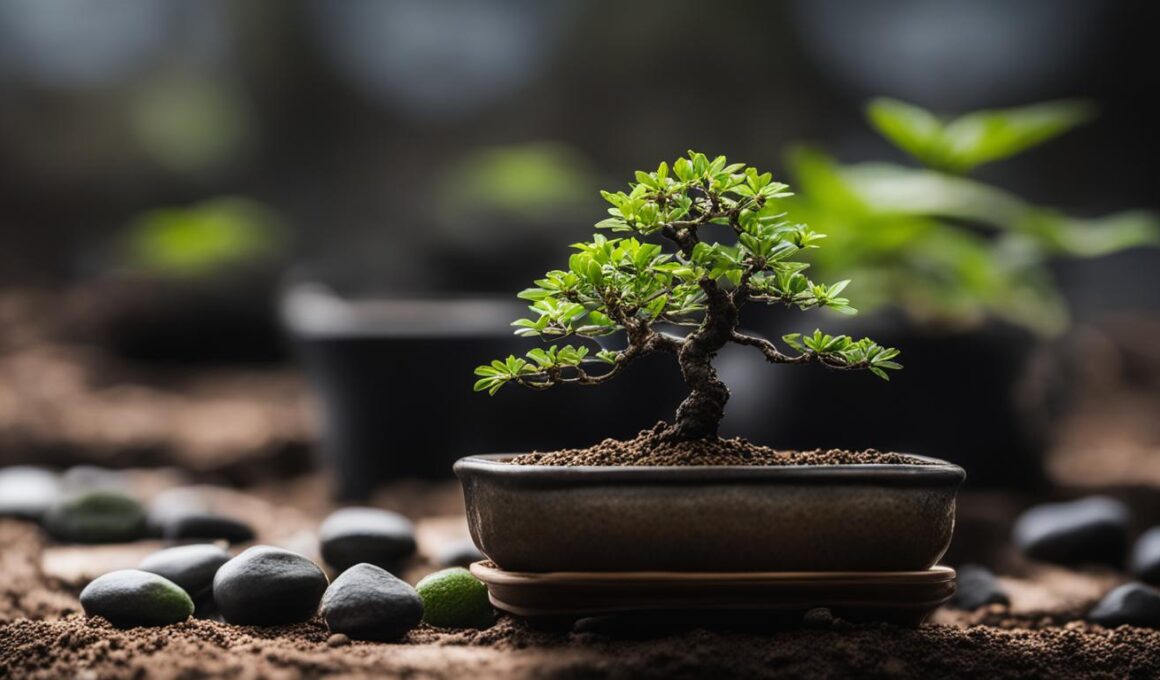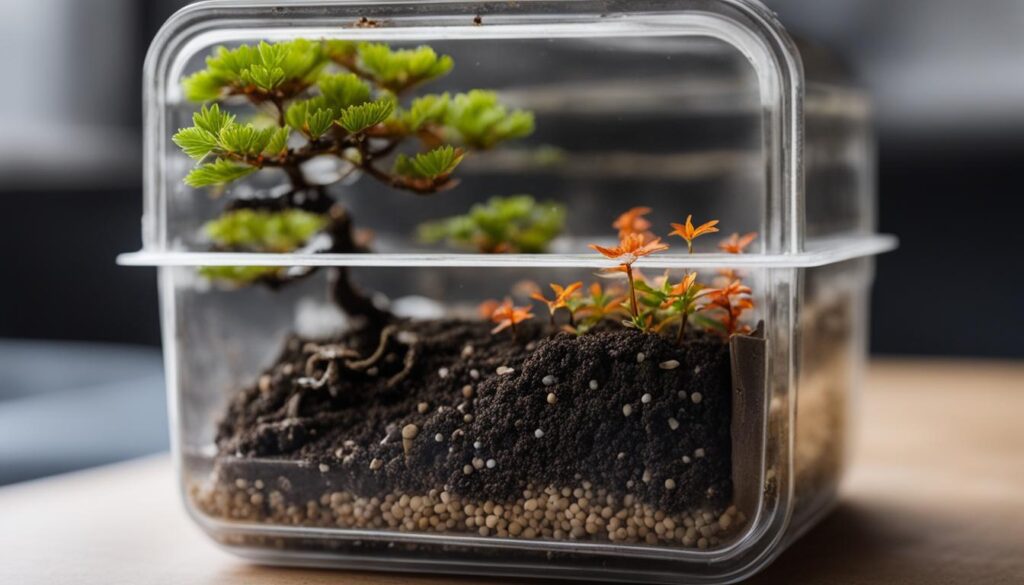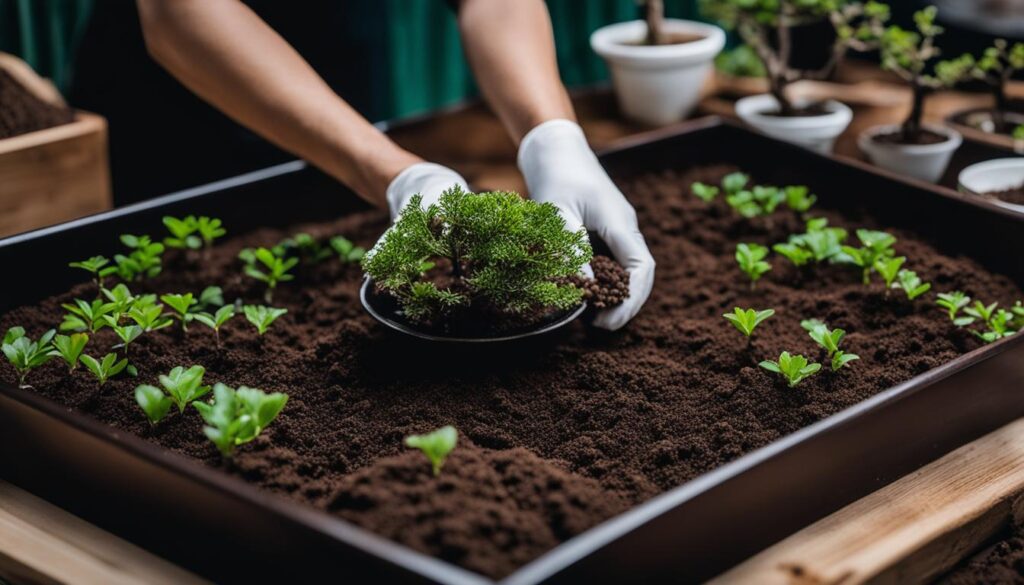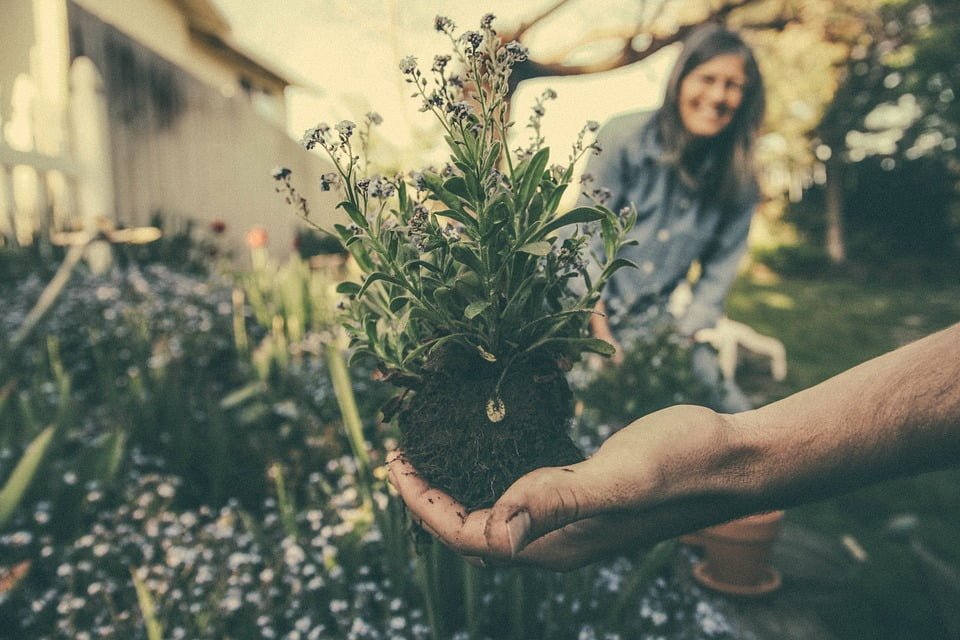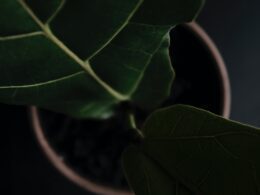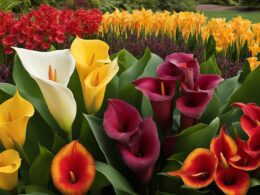Growing a bonsai tree from seeds is an enriching journey that requires patience, discipline, and a keen eye for detail. Unlike nursery-grown saplings, cultivating a bonsai tree from seed allows you to fully control its growth and development from the very beginning. There are no special “bonsai tree seeds” available in nature, as bonsai are ordinary tree species artfully crafted through pruning and shaping. By following the right steps and methods for growing bonsai from seeds, you can transform simple tree seeds into stunning miniature trees proudly displayed in your home or garden.
Key Takeaways
- Bonsai trees are cultivated from regular tree seeds, as there is no distinct species specifically for bonsai.
- Source the appropriate seeds, whether from native environments or online bonsai shops, to begin your bonsai cultivation journey.
- Stratification is a vital germination technique for seeds that are out of season or originate from differing climates.
- Timing, soil quality, and environmental conditions are essential factors in determining the success of planting bonsai seeds at home.
- Patience and dedication are crucial in nurturing seedlings as they grow and develop into pre-bonsai trees, ready for further styling.
Understanding Bonsai Seeds and Their Origins
Despite popular belief, there is no specific species of trees reserved exclusively for the cultivation of bonsai. The term bonsai seeds is a marketing label applied to regular tree seeds to appeal to hobbyists. Knowing the origins of the seeds you wish to use for bonsai is essential to the successful cultivation of your bonsai tree. In this section, we will explore the differences between native and exotic bonsai seeds, their cultivation techniques, and the factors that influence their ability to thrive.
- Native Bonsai Seeds: These seeds come from tree species that naturally grow in your local environment. Since they are already adapted to the climate and conditions of your area, they stand a better chance at thriving during the cultivation process.
- Examples: Eastern White Pine, American Elm, Red Maple
- Local seed sources: parks, forests, and botanical gardens
- Benefits: climatic adaptability and availability
- Examples: Japanese Maple, Chinese Elm, Australian Pine
- Exotic seed sources: specialized online bonsai shops
- Risks: may need additional care or treatments due to different climate conditions
| Seed Type | Examples | Adaptability | Cultivation Techniques |
|---|---|---|---|
| Native Bonsai Seeds | Eastern White Pine, American Elm, Red Maple | High | Plant in well-draining soil, water regularly, provide ample sunlight |
| Exotic Bonsai Seeds | Japanese Maple, Chinese Elm, Australian Pine | Variable | May require specific soil, temperature, and humidity adjustments depending on their native climates |
In conclusion, both native and exotic bonsai seeds can successfully grow into beautiful bonsai trees with proper care and attention. By understanding their origins and their adaptability to your area’s climate and conditions, you can ensure their success in your bonsai garden. Wisely choosing your seeds based on your knowledge and level of expertise is crucial for mastering bonsai cultivation techniques and enjoying the rewarding journey of nurturing your miniature tree.
Choosing the Right Seeds for Your Bonsai
Selecting the right bonsai seeds involves a careful process that takes into account various factors such as native, suitable local tree species, and the availability of exotic seeds from online bonsai shops. Moreover, it is crucial to opt for genetically compatible bonsai seeds to ensure successful germination and overall plant health.
Identifying Suitable Local Tree Species
When selecting bonsai seeds, it’s essential to begin by identifying suitable local tree species for bonsai that are well-adapted to your climate. Since native bonsai seeds are already acclimated to your environment, they have a higher likelihood of flourishing. The ideal time to gather these seeds is during autumn, allowing them to be planted immediately without requiring additional treatments, and aligning with nature’s rhythm.
Online Shops: A Gateway to Exotic Seeds
Online bonsai shops offer a convenient platform to access a wide range of exotic and unique bonsai seeds that may not be available locally. These shops provide a diversity of species, enabling the cultivation of an exotic bonsai collection. However, it is essential to pay close attention to the stratification requirements for these foreign species as they will likely differ from native options. In order to ensure successful germination and growth, consider the following when purchasing bonsai seeds from online shops:
- Research the specific growing requirements of the exotic species, such as light, temperature, and water preferences.
- Consult expert forums or bonsai enthusiasts familiar with the particular species’ care.
- Verify the reputation and reviews of the online shop to ensure authenticity and quality seeds.
The Importance of Genetically Compatible Seeds
Choosing genetically compatible bonsai seeds is a crucial aspect of bonsai seed selection, as it ensures that your bonsai will be well-suited for the climate and conditions where it will be grown. Planting genetically compatible seeds increases the likelihood of successful germination and healthy growth, regardless of whether the seeds are collected locally or acquired from different regions through online shops. To select genetically compatible seeds:
- Opt for seeds that are native or well-adapted to your local climate.
- Consult regional horticultural experts or botanical gardens for recommendations.
- Consider the general hardiness and adaptability of the chosen species for bonsai cultivation.
Prepping Seeds with Stratification for Successful Germination
Stratification is a crucial step in preparing bonsai seeds for successful germination, especially for those collected out of season or from different climates. Seed stratification for bonsai involves simulating the natural cold conditions that seeds would experience throughout the winter, promoting the seed’s ability to germinate in early spring. This is essential in achieving the desired outcome when utilizing bonsai seed germination techniques.
The process of prepping bonsai seeds through stratification entails several steps, which are outlined below:
- Soaking seeds in water for a duration that depends on the specific species.
- Wrapping seeds in moist paper towels, if the species requires it.
- Refrigerating the seeds for a set time, which varies based on the tree species.
- Removing seeds from the refrigerator when the stratification period is complete.
- Stepping up heat and light levels to encourage germination.
| Tree Species | Soaking Duration | Stratification Period |
|---|---|---|
| Japanese Maple | 24 hours | 90 – 120 days |
| Scots Pine | 24 hours | 21 days |
| Chinese Elm | 24 – 48 hours | 90 days |
| Bald Cypress | 24 hours | 30 days |
| Siberian Elm | 24 hours | 60 – 90 days |
It’s essential to understand that the stratification and prepping requirements may vary between seed species and origin. As such, it’s crucial to thoroughly research the specific requirements of the tree species you are cultivating.
Note: Stratifying seeds is essential to achieving successful germination with exotic seeds from different climatic regions. Be cautious when purchasing seeds online, as some sellers may fail to provide accurate stratification information, which could hinder your seed germination results.
Sowing Your Seeds: Best Practices and Timing
Understanding the best time to plant bonsai seeds and creating the perfect environment for germination are crucial factors to successfully grow bonsai trees from seeds. This section focuses on the optimal seasons for bonsai planting, soil preparation, and maintaining moisture and temperature levels.
Optimal Seasons for Planting Bonsai Seeds
The optimal season for planting bonsai seeds is during autumn, as it allows the seedlings to germinate in spring and grow throughout summer. This bonsai sowing schedule eliminates the need for artificial stratification, aligning with the natural germination cycle of the seeds. By adhering to these optimal seasonal guidelines, you increase the chances of successful bonsai seed germination and growth.
Creating the Ideal Soil Environment
Proper bonsai soil preparation is essential for your seeds to thrive. Use a specific seed-starting soil mix that promotes proper germination. The ideal soil for bonsai seeds should be well-drained and slightly acidic. Additionally, ensure the bonsai seedling soil environment is kept moist but not soggy to prevent rot and mold, striking the perfect balance for the seeds to sprout and grow.
- Select a well-draining seed-starting mix
- Opt for slightly acidic soil
- Maintain moist but not soggy soil
Utilizing a seed heating mat can help maintain the optimal soil temperature for germination, promoting a healthy bonsai seed germination environment.
Maintaining Moisture Levels and Temperature
Consistent moisture and temperature are key elements in successful bonsai seed germination. The soil must be kept consistently damp throughout the germination period, ensuring proper bonsai moisture control. To achieve this, lightly mist the soil with water and cover the container with plastic wrap or a humidity dome to retain moisture.
Temperature regulation for bonsai seeds is equally important and varies depending on the seed species. Some species may require temperature ranges between 65°F to 85°F for successful germination. Tools such as seed heating mats aid in maintaining the correct temperature for your seeds, creating an ideal germination environment.
| Bonsai Seed Species | Optimal Germination Temperature |
|---|---|
| Japanese Maple (Acer palmatum) | 65°F – 75°F |
| Japanese Black Pine (Pinus thunbergii) | 70°F – 85°F |
| Chinese Elm (Ulmus parvifolia) | 70°F – 80°F |
| Trident Maple (Acer buergerianum) | 65°F – 75°F |
| Ficus (Ficus spp.) | 75°F – 85°F |
By following these best practices and adhering to the optimal seasons for bonsai planting, you increase the likelihood of successful germination and the growth of your bonsai trees from seeds.
Nurturing Seedlings: From Germination to Pre-Bonsai
Nurturing bonsai seedlings requires consistent care and attention to detail, starting from the moment of germination until they reach the pre-bonsai stage. To successfully cultivate and care for young bonsai plants, it’s vital to follow a series of essential steps that will ensure the seedlings’ healthy growth and development.
- Transplanting Seedlings: Once your seedlings have germinated and developed a healthy root system, it’s time to transplant them into individual pots containing the appropriate soil mix. This will provide them with the necessary space and nutrients for further growth.
- Adjusting Conditions: As your seedlings continue to grow and develop, it’s crucial to monitor and adjust their lighting, watering, and humidity levels accordingly. Each species of bonsai will have specific requirements to thrive, so be sure to research the demands of your chosen species.
- Pruning and Wiring: As your bonsai seedlings mature, you can begin introducing basic bonsai styling techniques, such as loose wiring and pruning. This allows you to slowly shape and train the branches and trunk growth patterns while the saplings are still young and flexible.
- Thinning Out: Focusing on the healthier and more vigorous growths, start thinning out weaker seedlings and using the remaining plants to continue your bonsai journey. This ensures that only the strongest plants will progress to the pre-bonsai stage.
- Transitioning to Bonsai Pots: Once your seedlings have reached the pre-bonsai stage, you may begin to consider transitioning them into suitable bonsai pots. This stage allows for the final styling, shaping, and pruning of your young plants as they continue to develop.
In addition to these necessary steps, a successful transition from bonsai germination to the pre-bonsai stage will also require patience and dedication. Remember that growing bonsai is an art, and nurturing seedlings is a slow and rewarding process.
| Step | Description |
|---|---|
| 1. Transplanting Seedlings | Move germinated seedlings into individual pots with appropriate soil mix. |
| 2. Adjusting Conditions | Monitor and adjust lighting, watering, and humidity levels to suit the seedlings’ developmental stages. |
| 3. Pruning and Wiring | Introduce basic bonsai styling techniques like loose wiring and pruning to shape and train growth patterns. |
| 4. Thinning Out | Focus on healthier growth and remove weaker seedlings to improve overall plant strength. |
| 5. Transitioning to Bonsai Pots | Move pre-bonsai seedlings into suitable bonsai pots for final styling, shaping, and pruning. |
Aiming for the perfect balance of gentleness and assertive control, you’ll be well on your way to successfully nurturing bonsai seedlings from germination to the pre-bonsai stage, ultimately creating living works of art that will continue to flourish under your dedicated care.
-What Are the Light Requirements for Growing Bonsai Trees from Seeds?
When growing bonsai trees from seeds, it’s essential to understand the bonsai tree sunlight requirements. Bonsai trees thrive in bright, indirect sunlight for optimal growth. It’s important to place your bonsai tree in a location where it can receive ample sunlight without being exposed to harsh, direct sunlight for extended periods.
Conclusion
Growing a bonsai tree from seeds is a rewarding, albeit long-term, journey that entails a deep understanding of the cultivation process. The art of bonsai from seed allows you to shape the tree’s development from the very beginning and create a truly individualized piece of living art. With your dedication and patience, you can experience the fulfillment of nurturing a bonsai tree through its various stages of growth, from selecting the right seeds to guiding its mature growth.
Throughout the bonsai tree cultivation process, you are responsible for creating optimal growing conditions and attending to the specific needs of your unique tree. By understanding the stratification techniques necessary for different seed species and providing consistent care as your seedlings develop, you can set yourself up for success in your bonsai growing journey.
As you reflect on your bonsai growing journey, remember that the commitment and effort you put into cultivating your tree is the foundation of a stunning, living piece of art. The end result, a thriving bonsai masterpiece, will be a testament to your perseverance and passion in this exquisite horticultural endeavor. Embrace your growing bonsai from seed final thoughts and cherish the rewarding experience of nurturing a tree from its inception.





